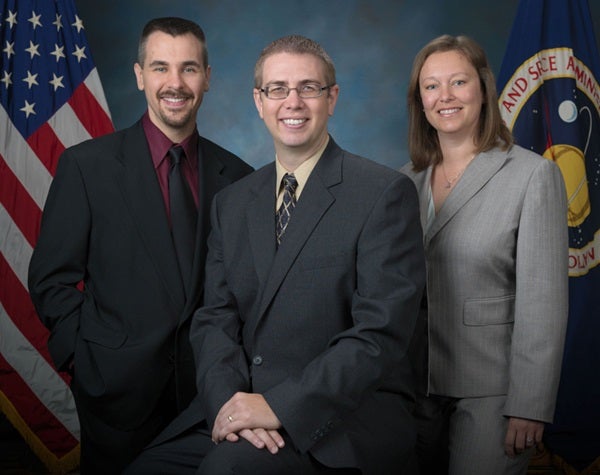NASA has selected three new flight directors who will manage and carry out shuttle flights and International Space Station expeditions. Dina Contella, Scott Stover, and Ed Van Cise will join a select group of individuals who lead human spaceflights from Mission Control at NASA’s Johnson Space Center in Houston.
“Since the first flight director, Chris Kraft, was selected during the Mercury era, 77 men and women have served as flight directors. One of the new flight directors will be the 80th in the history of U.S. human spaceflight,” said John McCullough, chief of the Flight Director Office at Johnson. “Dina, Scott and Ed are senior flight controllers who have lead management experience and an average of 10 years of flight control experience.”
A flight director leads and orchestrates planning and integration activities with flight controllers, payload customers, international partners, and technical and program support across the agency. Flight directors also are involved in developing plans and reviewing systems for future Constellation Program exploration missions. All of the recently selected individuals will begin training as space station flight directors.
“This group will help us transition the knowledge and experience from the existing human spaceflight programs into the development and execution of our exploration program with the new Orion spacecraft in the years to come,” McCullough said.
Contella was born in Austin, Texas, and earned a bachelor’s degree in aerospace engineering from Texas A&M University in 1992. She began working at NASA in the cooperative education program in 1990. Since 1995, Contella has served as a space shuttle and space station flight controller and astronaut instructor responsible for planning, training, and executing spacewalks.
Contella served as the lead spacewalk, or Extravehicular Activity Officer, liaison to Russia during early station construction. After the Columbia accident, she was instrumental in the development of repair tools and techniques for the space shuttle’s thermal protection system. From 1993 to 1995, Contella was an astronaut instructor in the Shuttle Data Processing System Navigation group.
Stover was born in Chambersburg, Pennsylvania, but considers Lemasters, Pennsylvania, to be his hometown. He earned a bachelor’s degree in aerospace from Pennsylvania State University in 2000, and a master’s degree in Space Architecture from the University of Houston in 2004.
Since 2000, Stover has supported six space shuttle assembly flights to the station as a member of the Power, Heating, Articulation, Lighting and Control (Phalcon) team that manages the space station’s electrical power system. He has led the group since 2008. He was group leader during a space station expedition mission and two shuttle missions, including the STS-120 mission, supporting the relocation and reactivation of the Port 6 power module and the Harmony node.
Van Cise was born in Bay City, Michigan, and earned a bachelor’s degree in aerospace engineering from the University of Michigan, Ann Arbor, in 2000. Van Cise joined NASA as a member of the Operations Support Officer (OSO) which coordinates station repair, maintenance, and assembly operations in 2000. Most recently, he has served as special assistant to the director of Mission Operations in a leadership development assignment.
Prior to that, Van Cise had been lead of the Mechanisms and Maintenance Training Group since 2007, responsible for the training of astronauts and flight controllers in skills and techniques needed to repair, maintain, and assemble the station. In 2006, he was on staff in the Flight Director Program Integration Office, and worked as a space station flight controller for the OSO and Telemetry, Information, Transfer and Attitude Navigation (Titan) groups. The Titan discipline oversees attitude control, communications and command, and data handling systems of the station during Houston nighttime and weekend hours.










